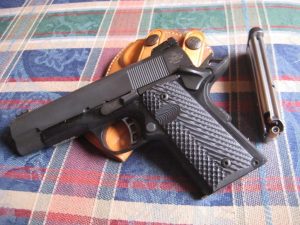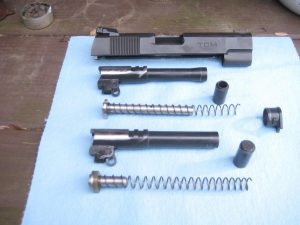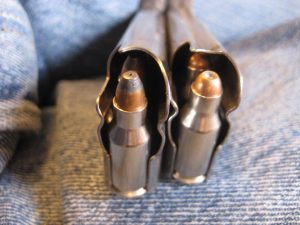By John Markwell | Contributing Editor

Ready for everyday carry, the TCM CCO in 9mm is a solid defensive pistol for the budget minded. Loaded with Federal Hydra-Shok ammo it is up to the task.
One’s first impression upon firing the Rock Island Armory’s 22TCM cartridge from a pistol is that it is loud; Really loud! Like .357 Magnum +P loud.
The startling thing is there is little to no recoil when the little 39-grain bullet exits the barrel. We reached out to the RIA folks for a sample switch-barrel CCO sized 1911 pistol chambered for the .22TCM/9mm mainly out of curiosity about the .22TCM cartridge. As RIA’s model numbers/descriptions can be a bit confusing the actual factory designation of the model we obtained is, for clarity; M1911-A1 CCO .22TCM9R/9mm G10 Aluminum; part #51858W.
The .22TCM cartridge was cooked up by gunsmith Fred Craig and Rock Island Armory CEO Martin Tuason; hence the moniker TCM (Tuason Craig Magnum). There are two different proprietary loads for the .22TCM featuring either 39 or 40 grain projectiles. The .22TCM 40-grain load seems to be designed to function from .38 Super-sized magazines while the .22TCM9R with its 39-grain bullet is designed to function in 9mm-sized magazines. Which version a given pistol uses seems to be determined by the magazine’s depth front to rear; more details on this later. RIA makes 9mm sized 1911s to run with the .22TCM9R as well as a Glock conversion unit. If this all seems a bit confusing, believe me it is.

Two barrels and recoil spring systems give the TCM CCO switch barrel pistol true versatility. The 9mm recoils spring guide has a shok-buf installed.
When we received our sample 9mm/22TCM pistol, which is designed to run with the 39Gr. 22TCM9R, the ammunition we received was the 40Gr. version which is a bit too long to fit in the 9mm magazines. Seems even the RIA folks have a bit of trouble with this. The 40gr load has a longer over all length than the 39 gr. 9R load but either can be fired in any TCM chambered gun; the magazines make the difference.
The RIA .22TCM9R CCO comes with two 4.25” barrels (9MM and 22TCM) with separate recoil springs (7lb. for the TCM cartridge and 14lb. for 9mm). The recoil spring guide is of the full-length variety which we admit to not having any affection for in 1911 pistols. For our 9MM shooting we replaced the full- length guide rod with an original Commander spring guide and plug. We reserved the full-length guide rod set-up for use with the .22TCM9R cartridge. This RIA 1911 CCO is pretty typical of the genre; Officer’s Model aluminum frame with G 10 grips, Commander length slide and all the typical controls which, worked perfectly by the way. The slide stop and magazine release are nicely checkered and the standard sized thumb safety is grooved both top and bottom. The aluminum frame has nice ball milled grooves in the front strap and a lightly beveled mag well. The 25 LPI checkered mainspring housing is also aluminum and the comfortable, nicely fitted, beavertail grip safety with grooved “memory bump” is steel. As most know, one of the beauties of 1911 pistols is their great single action triggers; even the bad ones are better than the triggers in most striker fired guns. The RIA CCO’s trigger pull was a bit spongy but the break was clean enough at a consistent 3.75-pounds. The slide of the RIA TCM is carbon steel with, thankfully, only rear cocking serrations, a well-executed lowered and flared ejection port and ball end mill cuts matching the dust cover of the frame. The sight set up is quite good with a red fiber optic front blade and a fully adjustable LPA rear unit with white dots (which we blacked out).
While we were awaiting the arrival of the .22TCM9R ammo, we ran about 500 rounds of Federal 124-grain 9mm ball ammunition through the compact pistol. The LPA rear sight allowed the zero on the pistol to be easily tweaked to put the point of impact at the top of the front sight at 15 yards. The two factory provided magazines (made by Mec-Gar) each hold 9 rounds and functioned flawlessly. We added a bumper pad to one of the mags to facilitate reloads; the other was left plain to fit flush in order to aid in concealment.
As a 9mm defensive pistol, the RIA TCM was more than adequate in the performance department. With either 124-grain 9mm ball or Federal 124-grain Hydra-Shok ammo, the TCM CCO kept all its shots well within the A zone of a standard IPSC target at 20 yards. Shooting drills from concealment, we found the bottom, or heel, of the checkered mainspring housing often snagged on our cover garment; a bit of de-horning would help with this. Working at speed we found the pistol to be generally devoid of sharp edges. Even though most of the corners are not radically beveled they are not sharp either. Although we are big fans of gold bead front sights, we found the red fiber optic front sight to be quite vivid and easy to acquire. We personally don’t know anyone who uses a fiber optic front sight on a duty pistol although I’m sure some who carry on a daily basis do. Fiber optic front sights are obviously effective but they seem a bit fragile and that’s probably why they sell replacement rods. As a 9mm defensive pistol, the RIA TCM9R CCO is reliable, accurate and, during our range sessions, measured up to the task admirably.

.38 Super magazine with the 40gr. TCM cartridge is on the left; 39-grain 22TCM 9R cartridge in a 9mm mag is on the right.
When we received our supply of .22TCM 9R ammunition we switched out the barrel, recoil spring and guide rod in about four minutes. With the pistol converted to .22TCM we headed down to the range to fire our first shots with the 22TCM cartridge. As mentioned in the first paragraph, the muzzle blast was LOUD with a large accompanying doughnut of flame. Very similar to shooting a S&W .22 Remington Jet revolver, there was little recoil. With the sights zeroed for the 9mm, the point of impact was 2 inches low at 10 yards and right on the money at 25 yards. We wondered about the magazine compatibility of the two different .22TCM loads so we dug out a couple of Officer’s-length .38 Super magazines and, yep, the longer 40 gr. TCM rounds went right in and fed just fine. We queried the Rock Island folks via the 1911 Forum about magazine compatibility and received the following reply from them: “You’re not missing anything. The .22TCM (40gr. load) came out first and many simply prefer shooting it in the 1911; some claim reliability, others like the looks of the longer round. Our 9mm/22TCM combos come with 9mm mags, requiring the use of the (39gr.) 9R. I shoot both from my CCO and have no issues with either round.” Armscor Global Defense, Inc. Vice President.
Not mentioned was whether the respondent used .38 Super mags but we’d bet he did with the 40 gr. TCM load. For those wishing to try the .22TCM cartridge without buying a complete new pistol there are Glock 17 and 19 conversion units and assorted barrels compatible with 1911 pistols (some fitting may be required) for sale on EBay for + or- $150. RIA also offers a bolt action rifle chambered for the 22TCM.
Much like the .22 Remington Jet and .22 Hornet, the .22TCM cartridge chronographed at a bit under 2000FPS with its’ nominal 40gr bullet; actual velocity was 1892fps. The TCM 9R with the 39gr. bullet clocked in at 1,915 fps. Either of these loads would be just dandy for use on closely called varmints up to and including those the size of Foxes and Coyotes. With a muzzle energy of close to 400 ft-lbs. the TCM cartridge would also be suitable for the recoil conscious to use as a self-defense round; that is if they could stand the muzzle blast and flash. For reference a 9mm 115 gr bullet at 1,200 FPS gives one just over 350 ft-lbs. of muzzle energy. Finally, the .22TCM round is just plain fun to shoot; it will impress your friends but will not make many new ones if you shoot it on an indoor range. The TCM R9R CCO pistol is a good bargain as 1911s go these days. With the switch barrel capability, you essentially get two guns for the price of one which, at today’s street price, is about $650 +or- a few bucks. If one is looking for a reasonably priced defensive pistol that offers the added utility of a .22 caliber centerfire the Rock Island TCM CCO or any of the other RIA switch barre pistols are definitely worth a hard look.



